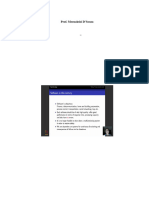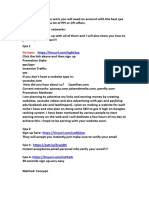ProperProgramming
Uploaded by
xlabcoderProperProgramming
Uploaded by
xlabcoderIf it is used properly, "On Error Resume Next" is a valid method of dealing with errors - but it is a method
that needs to be used appropriately for the situation.
While using it means that you don't get any 'annoying' error messages that stop your program, it can easily
cause much bigger problems than that, such as:
If one error happens, then the code after that point is likely to have errors too (especially if the first error
occurred while doing something like setting the value of a variable).
The follow-up error(s) that occur may be simple and 'safe', such as getting the wrong result displayed on
screen (but not knowing it is wrong)... or they could be much more serious, such as accidentally deleting an
important file, because you had an error getting the name of the file that you wanted to delete.
If you have made any coding mistakes (such as putting a text value into an Integer variable) then your code
wont do what it is supposed to do, and you wont know why.
Not only is the problem hidden from you, but so is the location of it. If you are running within VB, you would
normally get the line highlighted - but with "On Error Resume Next" you wont. In fact, you wont even know
that there was an error, all you will know is that you have made some kind of mistake somewhere in that
routine.
If you don’t know what the problem is, or where it is, how will you fix it?
What will the users of your program think if it gives them the wrong results? ..or does something nasty by
mistake? They wont be happy, and they certainly wont think that you are a great programmer!
As you are reading this article, you probably think that errors are a bad thing, and so hiding them is a good
idea. As you get more experience you find that this is not the case, and errors are actually a good thing - they
tell you either that you have done something wrong (and why it is wrong), or that something your program
relies on isn't working (but you didn't write code to deal with that).
In either case, VB wants to tell you what the problem is.. but rather than let it tell you (by using proper error
handling, or none at all), or deal with the error appropriately (perhaps by exiting the routine), you have
decided to put your fingers in your ears and shout 'I'm not listening!'
So when/how should I use it?
There are two kinds of situations where it is appropriate:
You really don’t care if the code runs properly or not, as it can't do any damage.. you hope!
You are expecting errors in certain part of a routine, but due to the size/structure of the routine (or what that
particular piece of code does) it's better to deal with the error where it happened (by checking Err.Number
immediately afterwards), rather than in an error handler that for the whole routine.
If you use the first kind regularly (more than about 10% of your error handling), I'm worried!
Using the second kind is fine, and is the ‘proper’ use. Just make sure that you revert to normal error handling
after that piece of code (or have error checks all thru the routine), otherwise you are back to the problems
mentioned above.
In most cases, you should be using proper error handling, as explained in this article.
Last edited by si_the_geek; Feb 19th, 2008 at 01:30 PM. Reason: added "errors aren't bad" section
You might also like
- Structural Analysis by Direct Stiffness Method100% (2)Structural Analysis by Direct Stiffness Method3 pages
- Insidious Bugs or - How I Stopped Worrying and Learned To Love Exceptions - VerySimpleNo ratings yetInsidious Bugs or - How I Stopped Worrying and Learned To Love Exceptions - VerySimple5 pages
- Visual Basic 6 Error Handling: Our Program BombsNo ratings yetVisual Basic 6 Error Handling: Our Program Bombs9 pages
- Debugging Techniques: Troubleshooting Computer ProblemsNo ratings yetDebugging Techniques: Troubleshooting Computer Problems18 pages
- Thinking About Errors in Your Code DifferentlyNo ratings yetThinking About Errors in Your Code Differently7 pages
- Handling and Logging Errors in VB ProgramsNo ratings yetHandling and Logging Errors in VB Programs4 pages
- Debugging & Error Handling For PresentationNo ratings yetDebugging & Error Handling For Presentation30 pages
- CS 312 Lecture 26 Debugging Techniques: Bug Prevention and Defensive ProgrammingNo ratings yetCS 312 Lecture 26 Debugging Techniques: Bug Prevention and Defensive Programming5 pages
- Confident Programmer Problem Solver: Six Steps Programming Students Can Take to Solve Coding ProblemsFrom EverandConfident Programmer Problem Solver: Six Steps Programming Students Can Take to Solve Coding ProblemsNo ratings yet
- Debugging Techniques - Software Design and DevelopmentNo ratings yetDebugging Techniques - Software Design and Development1 page
- The Hitchhiker's Guide To The UnexpectedNo ratings yetThe Hitchhiker's Guide To The Unexpected29 pages
- 2017-03-16-Intro-to-Java-2-anatomy of A Java Program-EnNo ratings yet2017-03-16-Intro-to-Java-2-anatomy of A Java Program-En2 pages
- Vocabulary: Your Computer Is Infected With A Virus, Isn't It?No ratings yetVocabulary: Your Computer Is Infected With A Virus, Isn't It?5 pages
- Sample Bug Report, How To Write Bug Report, Bug Life CycleNo ratings yetSample Bug Report, How To Write Bug Report, Bug Life Cycle8 pages
- Learn Programming by Coding Like a Professional: Create Games, Apps, & ProgramsFrom EverandLearn Programming by Coding Like a Professional: Create Games, Apps, & ProgramsNo ratings yet
- 2-2 - Understanding Errors, Exceptions, and BugsNo ratings yet2-2 - Understanding Errors, Exceptions, and Bugs18 pages
- Rapid Software Testing Guide To Bug Reporting v1.6No ratings yetRapid Software Testing Guide To Bug Reporting v1.67 pages
- Presentations Are Communication Tools That Can Be Demonstrations, Lectures, Speeches, Reports, And More. Most of the Time, They’Re Presented Before an Audience. They Have a Variety of Purposes, Making Them Powe (1)No ratings yetPresentations Are Communication Tools That Can Be Demonstrations, Lectures, Speeches, Reports, And More. Most of the Time, They’Re Presented Before an Audience. They Have a Variety of Purposes, Making Them Powe (1)30 pages
- CompTIA A+ Core 2 Best Practice Procedures for Malware RemovalNo ratings yetCompTIA A+ Core 2 Best Practice Procedures for Malware Removal17 pages
- Exception Handling: What Is An Exception?No ratings yetException Handling: What Is An Exception?17 pages
- Teach Yourself Programming The Guide to Programming & Coding Like a ProfessionalFrom EverandTeach Yourself Programming The Guide to Programming & Coding Like a ProfessionalNo ratings yet
- Several Do It Yourself Ways of Speeding Up A Slow Windows ComputerNo ratings yetSeveral Do It Yourself Ways of Speeding Up A Slow Windows Computer25 pages
- Cyber Security for Beginners: How to Become a Cybersecurity Professional Without a Technical Background (2022 Guide for Newbies)From EverandCyber Security for Beginners: How to Become a Cybersecurity Professional Without a Technical Background (2022 Guide for Newbies)No ratings yet
- Videoedge 2U Network Video Recorder: Data SheetNo ratings yetVideoedge 2U Network Video Recorder: Data Sheet3 pages
- CompTIA Certkiller N10-006 v2015-03-28 by Veronica 124q PDFNo ratings yetCompTIA Certkiller N10-006 v2015-03-28 by Veronica 124q PDF61 pages
- HTML Cheat Sheet - A Simple Guide To HTMLNo ratings yetHTML Cheat Sheet - A Simple Guide To HTML6 pages
- Murderers VS Sheriffs Duels 1st (Working)No ratings yetMurderers VS Sheriffs Duels 1st (Working)3 pages
- King Fahd University of Petroleum and Minerals: Information & Computer Science DepartmentNo ratings yetKing Fahd University of Petroleum and Minerals: Information & Computer Science Department8 pages
- Bosch Video Management System - Configuration Manual100% (1)Bosch Video Management System - Configuration Manual260 pages
- Libraries Comm Controller DOC V1 1 1 enNo ratings yetLibraries Comm Controller DOC V1 1 1 en113 pages
- Practical Machine Learning With Python and Scikit LearnNo ratings yetPractical Machine Learning With Python and Scikit Learn23 pages
- HC 2023 AMD Ryzen 7040 Series Processor 8-26-2023No ratings yetHC 2023 AMD Ryzen 7040 Series Processor 8-26-202327 pages
- 9. Thiết Kế Đồ Án Công Nghệ Chế Tạo MáyNo ratings yet9. Thiết Kế Đồ Án Công Nghệ Chế Tạo Máy190 pages
- Manisha - Smart Phones Vs DSLR - Final - 2020No ratings yetManisha - Smart Phones Vs DSLR - Final - 202034 pages
- Control Hardware and IO Modules Firmware Upgrade Guide EPDOC-X150-en-501ANo ratings yetControl Hardware and IO Modules Firmware Upgrade Guide EPDOC-X150-en-501A45 pages
- Focus 35C/43C Detectors With Image Suite V4 SoftwareNo ratings yetFocus 35C/43C Detectors With Image Suite V4 Software2 pages
- Ellipse20Service20Manual20Rev04 1747554827 PDFNo ratings yetEllipse20Service20Manual20Rev04 1747554827 PDF229 pages

























































































